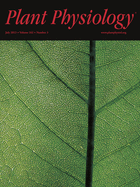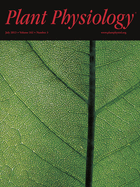
Cover image

On the Cover: Leaf venation of a sycamore tree (Acer pseudoplatanus). Photograph by Tom Donald (http://www.flickr.com/clearwood), a Scottish photographer and frequent contributor to The Plant Cell's Teaching Tools in Plant Science series.
Volume 162, Issue 3, July 2013
ON THE INSIDE
On the Inside
EDITORIAL
Associate Editor Graham Farquhar Receives Honors for His Research in Plant Physiology and Climate Change
UPDATES
Potassium Ion Channels: Could They Have Evolved from Viruses?
Phylogenetic analyses of small viral K+ channels suggests that they did not originate from their hosts, but instead could be the source of the postulated pore precursor in the evolution of K+ channels.
BREAKTHROUGH TECHNOLOGIES
Comprehensive Investigation of MicroRNAs Enhanced by Analysis of Sequence Variants, Expression Patterns, ARGONAUTE Loading, and Target Cleavage
A combinatorial approach of small RNA expression analysis with ARGONAUTE immunoprecipitation data and global cleavage data of RNA ends leads to a global picture of Arabidopsis microRNAs.
GoldenBraid 2.0: A Comprehensive DNA Assembly Framework for Plant Synthetic Biology
GoldenBraid 2.0 is a comprehensive technological framework that facilitates the construction of increasingly complex multigene structures and exchange of genetic building blocks.
Article
BIOCHEMISTRY AND METABOLISM
Diurnal Changes of Polysome Loading Track Sucrose Content in the Rosette of Wild-Type Arabidopsis and the Starchless pgm Mutant
Ribosome loading is closely coordinated with the sucrose supply during diurnal cycles in Arabidopsis.
Whole-Genome Mapping of Agronomic and Metabolic Traits to Identify Novel Quantitative Trait Loci in Bread Wheat Grown in a Water-Limited Environment
Comparison of the agronomic and metabolic trait variation between drought-sensitive and drought-tolerant wheat crosses uncovers novel correlations between agronomic traits and the levels of certain metabolites as well as important regions on the wheat genome that require further investigation.
The SUGAR-DEPENDENT1 Lipase Limits Triacylglycerol Accumulation in Vegetative Tissues of Arabidopsis
A triacylglycerol lipase knockout boosts the oil content of wild-type plants and transgenic plants genetically engineered to make more oil.
Comprehensive Dissection of Spatiotemporal Metabolic Shifts in Primary, Secondary, and Lipid Metabolism during Developmental Senescence in Arabidopsis
Spatiotemporal analysis during developmental senescence provides a rich catalog of metabolites in relation to leaf and silique development in Arabidopsis.
A Redox 2-Cys Mechanism Regulates the Catalytic Activity of Divergent Cyclophilins
A novel type of allosteric regulation in divergent cyclophilins engages disulfide bond formation and a loop-displacement mechanism.
A Common Fungal Associate of the Spruce Bark Beetle Metabolizes the Stilbene Defenses of Norway Spruce
The bark beetle-vectored fungus Ceratocystis polonica degrades stilbenoid defense compounds produced by its conifer host.
Comparative Transcriptome Analysis of Three Oil Palm Fruit and Seed Tissues That Differ in Oil Content and Fatty Acid Composition
Tissue-specific transcriptional regulation determines the differences in oil content and fatty acid composition of oil palm fruit and seed tissues.
CELL BIOLOGY
Nonredundant Function of Zeins and Their Correct Stoichiometric Ratio Drive Protein Body Formation in Maize Endosperm
Nonredundant and specialized functions of the zein prolamines control maize protein body formation and endosperm texture.
Coordination of Leaf Photosynthesis, Transpiration, and Structural Traits in Rice and Wild Relatives (Genus Oryza)
Linkages of leaf and mesophyll cell traits to CO2 diffusion, photosynthesis, transpiration, and water use efficiency were identified across accessions of the genus Oryza.
ECOPHYSIOLOGY AND SUSTAINABILITY
Abscisic Acid Mediates a Divergence in the Drought Response of Two Conifers
Differences in drought survival strategies of conifer species are linked to the interaction between hormone dynamics and water tension in the water transport system.
Arabidopsis Enhanced Drought Tolerance1/HOMEODOMAIN GLABROUS11 Confers Drought Tolerance in Transgenic Rice without Yield Penalty
AtEDT1/HDG11 improves stress tolerance and grain yield in rice.
PYR/RCAR Receptors Contribute to Ozone-, Reduced Air Humidity-, Darkness-, and CO2-Induced Stomatal Regulation
Signaling through abscisic acid PYR/RCAR receptors plays a fundamental role in controlling whole-plant stomatal conductance and affects stomatal closure in response to low air humidity, darkness, O3, and elevated CO2.
GENES, DEVELOPMENT, AND EVOLUTION
Localized Induction of the ATP-Binding Cassette B19 Auxin Transporter Enhances Adventitious Root Formation in Arabidopsis
Localized synthesis of an auxin transport enhances local IAA accumulation in excised Arabidopsis hypocotyls and drives the formation of adventitious roots.
The Moss Physcomitrella patens Reproductive Organ Development Is Highly Organized, Affected by the Two SHI/STY Genes and by the Level of Active Auxin in the SHI/STY Expression Domain
Reproductive organ development of the moss Physcomitrella patens is affected by two SHI/STY genes and the plant hormone auxin.
Functional Implication of β-Carotene Hydroxylases in Soybean Nodulation
Carotenoids are essential for nodule development in soybean.
Redox Modulation of Plant Developmental Regulators from the Class I TCP Transcription Factor Family
The activity of class I TCP transcription factors is modulated by cellular redox agents both in vitro and in vivo, suggesting their role in developmental redox control in plants.
Suspensor Length Determines Developmental Progression of the Embryo in Arabidopsis
Embryo suspensor length is crucial for fast developmental progression in Arabidopsis seed.
The Role of TIR-NBS and TIR-X Proteins in Plant Basal Defense Responses
TIR-NBS and TIR-X proteins are novel plant proteins with activities indicative of roles in plant defense.
The Cotton Transcription Factor TCP14 Functions in Auxin-Mediated Epidermal Cell Differentiation and Elongation
GhTCP14 is a dual-function transcription factor able to positively or negatively regulate expression of auxin response and transporter genes, and it may act as a crucial regulator in auxin-mediated differentiation and elongation of cotton fiber cells.
MEMBRANES, TRANSPORT, AND BIOENERGETICS
Mutually Exclusive Alterations in Secondary Metabolism Are Critical for the Uptake of Insoluble Iron Compounds by Arabidopsis and Medicago truncatula
Coexpression and promoter analysis under iron deficiency in roots of Arabidopsis and Medicago demonstrates the integral role for production and secretion of compounds that facilitate the uptake of reduction-based iron acquisition.
Vacuolar Transport of the Medicinal Alkaloids from Catharanthus roseus Is Mediated by a Proton-Driven Antiport
A specific H+ antiport system mediates the vacuolar uptake of terpenoid indole alkaloids in Catharanthus roseus.
Glutamate Receptor-Like Channel3.3 Is Involved in Mediating Glutathione-Triggered Cytosolic Calcium Transients, Transcriptional Changes, and Innate Immunity Responses in Arabidopsis
Extracellular glutathione triggers innate immunity responses in the Arabidopsis leaf through a glutamate receptor3.3-dependent pathway homologous with that of the central nervous system.
A Suppressor Screen of the Chimeric AtCNGC11/12 Reveals Residues Important for Intersubunit Interactions of Cyclic Nucleotide-Gated Ion Channels
A small subset of residues is essential for Arabidopsis CNGC12 channel subunit interaction.
SIGNALING AND RESPONSE
Structural Determinants at the Interface of the ARC2 and Leucine-Rich Repeat Domains Control the Activation of the Plant Immune Receptors Rx1 and Gpa2
Cooperative interactions between the sensor domain and the molecular switch domain of plant immune receptors are structurally defined.
TWIN SISTER OF FT, GIGANTEA, and CONSTANS Have a Positive But Indirect Effect on Blue Light-Induced Stomatal Opening in Arabidopsis
Stomatal opening is indirectly modulated by a mechanism similar to that of the photoperiodic floral transition.
Phototropins Function in High-Intensity Blue Light-Induced Hypocotyl Phototropism in Arabidopsis by Altering Cytosolic Calcium
High-intensity blue light induces increases in [Ca2+]cyt, which are mostly attributed to the function of phot2 and phot1, required for phototropism in Arabidopsis hypocotyls.
Interplay between Sucrose and Folate Modulates Auxin Signaling in Arabidopsis
Sugar and folate fine-tune hormone sensitivity and distribution to shape plant seedling development.
The Arabidopsis ETHYLENE RESPONSE FACTOR1 Regulates Abiotic Stress-Responsive Gene Expression by Binding to Different cis-Acting Elements in Response to Different Stress Signals
The transcriptional regulator ERF1 plays a positive role in salt, drought, and heat stress tolerance by integrating hormonal signals.
Growth Platform-Dependent and -Independent Phenotypic and Metabolic Responses of Arabidopsis and Its Halophytic Relative, Eutrema salsugineum, to Salt Stress
Eutrema salsugineum maintains its salt tolerance under very different growth conditions even though its development and metabolism show substantial growth condition-dependent differences.
Regulation of Transcription of Nucleotide-Binding Leucine-Rich Repeat-Encoding Genes SNC1 and RPP4 via H3K4 Trimethylation
MOS9 and ATXR7 contribute to the transcriptional regulation of Resistance genes SNC1 and RPP4 residing in the RPP4 cluster.
GIGANTEA Enables Drought Escape Response via Abscisic Acid-Dependent Activation of the Florigens and SUPPRESSOR OF OVEREXPRESSION OF CONSTANS1
Floral transition under drought conditions is accelerated by enabling ABA-dependent up-regulation of the florigen genes.
The Trehalose 6-Phosphate/SnRK1 Signaling Pathway Primes Growth Recovery following Relief of Sink Limitation
The T6P/SnRK1 mechanism of growth regulation responds to sink growth restriction and recovery following low-temperature limitation.
SYSTEMS AND SYNTHETIC BIOLOGY
System-Wide Hypersensitive Response-Associated Transcriptome and Metabolome Reprogramming in Tomato
A novel set of HR-related genes and secondary metabolites depends on WRKY transcription factors in tomato.
The Arabidopsis RING E3 Ubiquitin Ligase AtAIRP3/LOG2 Participates in Positive Regulation of High-Salt and Drought Stress Responses
A ubiquitin ligase has dual functions in ABA-mediated drought stress and in amino acid export in Arabidopsis.
Genome-Wide Detection of Condition-Sensitive Alternative Splicing in Arabidopsis Roots
Transcriptional profiling of roots subjected to iron and phosphate deficiency revealed stress-specific changes in splicing patterns that are largely independent of differential gene expression, providing a mechanism adapting gene activity to environmental conditions.


